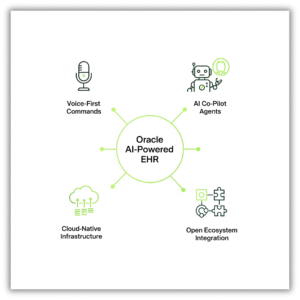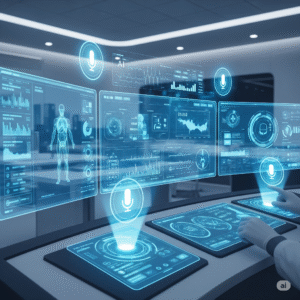Oracle’s New AI-Driven EHR Explained: What It Means for Your Clinic in 2025




 Imagine this. You are a physician about to see your next patient. Normally, you would be juggling screens, searching through cluttered tabs, and clicking endlessly to find lab results or past medications. But instead, you say out loud: “Show me Maria’s last cholesterol report and list her current medications.” In seconds, the information is on your screen, neatly organized and contextual. No distractions. No wasted clicks. Just clear, useful data.
Imagine this. You are a physician about to see your next patient. Normally, you would be juggling screens, searching through cluttered tabs, and clicking endlessly to find lab results or past medications. But instead, you say out loud: “Show me Maria’s last cholesterol report and list her current medications.” In seconds, the information is on your screen, neatly organized and contextual. No distractions. No wasted clicks. Just clear, useful data.
That is the promise of Oracle’s new AI-Driven EHR, launched in August 2025. And this is not just an incremental update. It is a complete reinvention of how electronic health records can and should work.
Healthcare has been calling for EHR reform for decades. Doctors have complained of endless paperwork, complex workflows, and technology that often feels like it slows care down instead of speeding it up. Oracle listened, and their answer is bold: a voice-first, AI-powered, cloud-native system that puts clinicians back in control.
So, let’s break this down.
Most EHRs today are like patchwork quilts, systems that have been built and rebuilt over decades, with new features bolted onto old infrastructure. The result? Clunky, rigid software that frustrates providers and burns out staff.
Oracle took a different approach. They started from zero. The new EHR was built entirely in the cloud, leveraging Oracle Cloud Infrastructure (OCI), which is optimized for AI. Instead of dragging old baggage forward, they tore the foundation down and rebuilt with AI as the cornerstone.
Think of it like upgrading from a flip phone to a smartphone. Sure, the flip phone technically worked, but it was limited and outdated. Once you switch to a smartphone, your entire way of working changes. Oracle’s goal is exactly that: a complete shift in how EHRs empower, rather than burden, healthcare providers.
Oracle’s new system is not just a prettier interface, it is a fundamental redesign of how clinicians interact with technology.
Doctors no longer need to click endlessly. Instead, they can speak naturally. “Pull up Emily’s allergies,” or “What medications was Robert prescribed last month?” The system interprets the request, understands context, and delivers precise information instantly.
It feels less like using software and more like having a trusted assistant who knows your patients inside out.

Oracle calls them “agents,” but think of them as intelligent co-pilots. These AI agents can flag unusual lab results, suggest next steps, or highlight potential risks in real time. Unlike static systems, they collaborate dynamically, surfacing the right insights at the right moment.
Imagine having a resident doctor shadowing every patient visit, whispering reminders, catching overlooked details, and offering helpful suggestions. That is what Oracle’s agents aim to replicate.
This is not surface-level AI. Oracle trained the system on vast amounts of medical data, from conditions and lab results to medications and care pathways. That means the AI understands relationships, like which medications align with specific conditions, and can help clinicians spot inconsistencies or risks before they escalate.
For example, if a physician prescribes a drug that might interact negatively with another medication the patient is already taking, the AI agent can flag it immediately.

Ask any doctor what they dislike most about EHRs, and you will hear the same thing: documentation and coding. Oracle’s EHR embeds AI directly into workflows, reducing manual entry and repetitive tasks. That means doctors spend less time staring at a screen and more time engaging with patients.
Think of it as moving from a typewriter to predictive text on your phone. Suddenly, the effort required drops dramatically.
Unlike many EHRs that lock customers into closed systems, Oracle designed this platform to be open. Clinics can build their own agents, extend Oracle’s library, or integrate third-party AI models. This future-proof approach ensures organizations will not be boxed in as technology evolves.
Oracle is not just targeting large health systems. Their strategy is to create an EHR that scales across the entire healthcare ecosystem.
Telehealth: With conversational AI, remote doctors can quickly pull patient history mid-consultation without breaking flow.
Pharmacies: Integrated medication histories reduce duplication and errors.
Insurance Providers: Smarter records streamline claims, approvals, and fraud detection.
Patients: Imagine a patient portal that answers questions like, “What were my last three blood sugar readings and how do they compare to normal ranges?”
This is not just an EHR for hospitals. It is a digital nervous system for healthcare.
The real impact is not just about faster clicks or fewer screens. It is about changing the relationship between clinicians and patients.
For small practices: A lightweight, cloud-based EHR means easy adoption without huge upfront costs.
For large systems: Scalable AI support reduces staff burden across departments, making workflows smoother.
For patients: More direct face time with doctors, personalized care, and less waiting around while clinicians wrestle with software.
At its core, Oracle’s EHR is about giving time back to clinicians. And time, in healthcare, is the most valuable resource.
It is worth pointing out that Oracle is not the only company in the EHR game. Epic, Cerner (ironically acquired by Oracle), and others dominate the market. But here is the difference: most competitors are adding AI as a side feature. Oracle built their EHR for the AI era from the ground up.
Seema Verma, EVP at Oracle Health, put it clearly: “Our competitors seem content with bolting features onto antiquated technology. We created an entirely new EHR, built in the cloud for the Agentic AI era.”
That mindset, to rebuild instead of retrofit, could set Oracle apart in a market that has long been overdue for disruption.
Let’s step back. Why does this matter beyond healthcare operations?
Burnout Prevention: Physician burnout has reached crisis levels, with documentation and administrative burden as top contributors. Oracle’s EHR directly tackles that by offloading repetitive tasks.
Data Democratization: By making EHRs voice-first and AI-powered, even non-technical staff can access insights without specialized training.
Health Equity: Better EHRs reduce gaps in care by ensuring no important detail gets buried in paperwork.
AI-as-a-Partner: This system reframes AI not as a replacement, but as a partner walking alongside clinicians, patients, and administrators.

Currently, the EHR is available for ambulatory providers in the U.S., with acute care functionality scheduled for 2026. Oracle’s roadmap points to broader adoption across hospitals and specialized care, signaling their intent to become the gold standard across the healthcare continuum.
And with its open AI ecosystem, clinics will not just consume technology, they will be able to extend and innovate on top of it. That is huge for organizations who want flexibility and control.
Q1: What makes Oracle’s EHR truly “AI-driven”?
Unlike traditional systems that simply add AI features on top of old workflows, Oracle’s EHR was designed with AI as its foundation. The voice-first interface, contextual understanding, and intelligent agents are not side tools, they are the core of the platform. This means every action is supported by AI, from pulling records to suggesting care steps. For clinicians, this translates into a smoother, more intuitive experience where the system anticipates needs instead of just responding to clicks.
Q2: Will this replace doctors or staff?
Absolutely not. The system is not here to replace healthcare professionals but to augment their work. Think of it like autopilot in aviation, it helps reduce workload but does not replace the pilot. Similarly, Oracle’s AI-driven EHR handles repetitive administrative tasks and surfaces insights so doctors can dedicate their attention to human care, empathy, and decision-making. The clinician remains in full control, always.
Q3: Is it secure enough for sensitive patient data?
Yes. Security is non-negotiable in healthcare, and Oracle built this system on Oracle Cloud Infrastructure, which comes with enterprise-grade encryption, HIPAA compliance, and continuous monitoring. Beyond compliance checkboxes, Oracle designed this EHR to actively limit risks through contextual AI that can help flag anomalies or inconsistent entries. In a world where data breaches can cost millions, this level of security is not just a feature, it is a necessity.
Q4: How quickly can providers start using it?
Ambulatory providers in the U.S. can begin as soon as regulatory approvals are finalized, which Oracle expects in late 2025. That means clinics could start rolling out the system this year. Acute care providers will have access in 2026, when Oracle releases the next wave of features.
Q5: Can smaller clinics afford this?
While Oracle has not released detailed pricing, cloud-native solutions usually reduce upfront costs compared to traditional on-premise systems. Smaller clinics often worry about being left behind by big tech innovations, but Oracle is signaling flexibility in pricing and scalability. Think subscription models instead of massive one-time investments, which makes it more feasible for smaller practices to adopt.
Q6: Will it integrate with existing systems?
Yes. Oracle emphasizes interoperability through open APIs and integrations. That means the system is not a “walled garden” and can connect with labs, imaging software, billing systems, and third-party applications. For providers, this means less double entry and more seamless operations.
Q7: How does this improve the patient experience?
The most immediate impact patients will notice is time and attention. When clinicians are not bogged down by documentation, they can focus fully on the patient in front of them. Patients will also benefit from more personalized insights since the AI understands context, conditions, and medications in real time. It is the difference between being treated as “patient ID 1253” and being treated as a whole person.
Q8: Is this really a game-changer or just another tech announcement?
It depends on execution, but all signs point to this being transformative. If Oracle delivers on its promises, conversational workflows, contextual AI, open innovation, this EHR could reset expectations across the industry. The difference will be in daily practice: fewer clicks, faster insights, and more meaningful patient interactions. That is where real change happens.
For decades, EHRs have been the bane of clinicians’ existence. Too much paperwork, too little value. Oracle’s AI-Driven EHR represents a fresh start, not just a software upgrade, but a philosophical shift. It is about giving time back to clinicians, restoring joy in practicing medicine, and creating a healthcare experience that feels more human again.
The question is not whether this technology will change healthcare, it is whether your clinic is ready to adopt it. The practices that move first will not only reduce operational burdens but also stand out as leaders in patient-centered, tech-enabled care.
If you are curious about what this could look like for your organization, we would love to help.
Contact us today and book a 30-minute strategy session. Together, we will map your path from legacy clicks to conversational care.